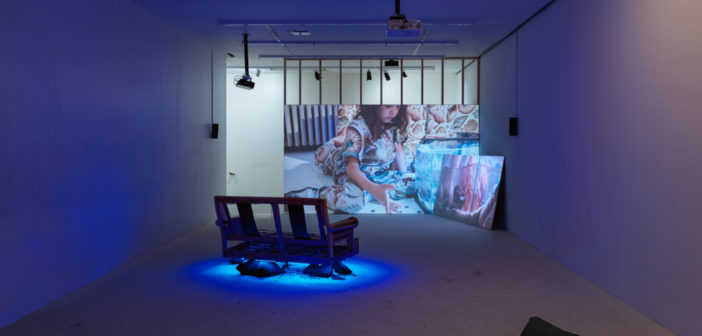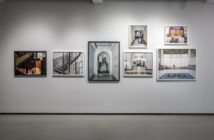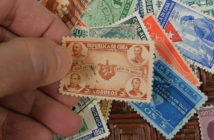When I found out that the artist A.K. Burns was one of the Radcliffe fellows at Harvard this year, I was excited to have gotten that memo because things come and go pretty quietly over there. My husband works next to the Radcliffe, so I walk by it often and tend to get nosy. Yet, a lot of it manages to still slip by me. Each year, distinguished artists and scholars from all over the world come to Cambridge for a year-long research residency. The artists often give a public talk and have a show at Radcliffe’s gallery. Tania Bruguera and Lamia Joreige are fellows this year, amongst others, and later in April, Radcliffe will host an exhibition by Xaviera Simmons.
I have been following A.K. Burns’ myriad projects for a while and have great respect for their breadth, scale and energy. I’m also mystified by them. The trajectory of her work, and the logic behind the way her references, objects, videos, and performances come together points to a headspace and process so different from my own. I was curious to find out more and the timing was perfect because A.K. was opening three shows in a row this season. I reached out for an interview and she was generous enough to oblige. Sarah Montross, Associate Curator at the deCordova, joined me as we visit A.K. in her Radcliffe studio soon after the opening of her exhibition Shabby But Thriving at the New Museum, and while she prepared for her upcoming show at Callicoon Fine Arts in New York. Burns has an upcoming talk and exhibition at the Radcliffe opening March 22, 2017.
-Lucy Kim
Participants: A.K. Burns (AK), Lucy Kim (LK), Sarah Montross (SM)
LK: You’re more than halfway through the Radcliffe fellowship. How’s it been for you? The studio space is nice, but bizarre because it’s bi-level.
AK: I complained a little when they first showed me pictures of the studio. How can you stage a show in a bi-level studio! (laughs) But it’s actually become strangely handy way to separate office-video work from the physical-saw dusty kind of work.
SM: You have three solo shows back to back - January, February, March. Did you know the shows were coming up when you got the fellowship?
AK: Oh yeah, when I got the fellowship I thought, oh my god, I might actually be able to do this. Having this much work to do, being isolated is very helpful. Basically, everything I need is taken care of. I’ve got coffee, assistants, and a studio. I can’t complain. Not worrying about where my income is coming from and not having the distraction of teaching right now is a real gift.
SM: Are you full-time teaching usually?
AK: I had a temp full-time gig last year at Hunter that I had to leave to come here, but generally I adjunct. People always say, “teaching full-time will ruin your career.” I don’t think so. There’s no way that it’s more work to have to go to some faculty meetings than juggling five different institutions making a third of the pay.
LK: Is teaching something you’re interested in continuing?
AK: For sure. I like to think of Amy Sillman as ideal example, someone who’s commercially successful, but for whom being pedagogically engaged is part of being an artist. Teaching also balances the narcissism of the studio. That said, I feel very fortunate to get to take a break and be completely in my own work for a year.
LK: You’ve been making work in Cambridge for 6 months now. How do you find Cambridge to work in?
AK: I don’t have much fondness for Boston, I will be honest.
LK: That’s okay, I’m not offended. I love it here, but I get it.
SM: It’s a hard-won city, I think.
AK: I went to RISD and spent a lot of time in college visiting Boston in the 90s’. Then I had an ex-partner who did her PhD at Harvard, and after that I did my first teaching gig at Mass Art, and commuted here, weekly for two years. So I’ve done a lot of time in Boston, somehow I keep getting pulled back. But it does help to be away from the cultural draw of NYC. I don’t have a lot of motivation to leave the studio here. That’s been great for my work.
SM: Is it unusual to have such close presentations of your work?
AK: Yes. The New Museum offer came first. They offered me a slot for January 2017, which gave me only about a year to make this video chapter (Living Room, 2017). The first video chapter (A Smeary Spot, 2015) took me three years, and that is my preferred speed. So I accepted the show under the guise that I would stage a work in progress. It turns out I’ve ended up with a complete chapter – Shabby but Thriving (the exhibition at the New Museum) very much exceeded my own expectations.
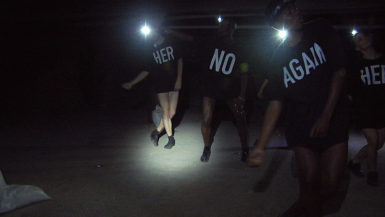
Still from Living Room, 2017, 2-channel HD video, color, sound; 36 min. Courtesy of the artist and Callicoon Fine Arts, NY.
LK: Do you feel like there’s any kind of shift in this new work that you’re showing this spring?
AK: I think A Smeary Spot (shown in Participant, NY in 2015) was the big shift for me. I spent 2007-2013 deeply involved in a number of collaborative projects (Community Action Center, The Brown Bear, The Poetry Parade, W.A.G.E. and Randy Magazine), so it felt important to make something large scale on my own. I continued to make my own work as well at that time, but it never felt like it had the gravitas of the collaborative projects. For me, A Smeary Spot marked a move away from overt collaboration, and the opening to a kind of opus, as I’m five years into something that is about 1/3 complete.
LK: I remember reading an interview where you talked about your childhood and how unusual it was. You grew up in California and your parents were hippies?
AK: Yeah, they lived for a short stint in a commune in Santa Cruz, but they divorced by the time I was three. I do recall living in the back of a camper at one point too. My parents should never have been together, but they were young, 20 and 22, when they had me. They moved back to where they grew up after the divorce to Palo Alto and Los Altos, California. I grew up mostly in the Mid-Bay Area - my mom ended up in Mountain View and my Dad stayed in Palo Alto and evolved into a yuppie. He went from a beard in the middle of his chest to a beard that’s trimmed. And my mom has had a nose ring since the ‘70s. She asked me while I was having my ears pierced for the first time, “Do you want a nose ring?” And I was 8! I remember thinking, “My mom is nuts.” Then the ’90’s came along and I got a nose ring too. But I spent a lot of my earlier years trying to be ‘normal,’ which was some idea I had gathered from the TV I wasn’t aloud to watch. Normal was the only form of rebellion I had.
SM: She knew what was best for you!
AK: Yeah, she was ahead of the curve and I was not having it. I feel mostly grateful, aside from some psychological mania, for having a non-traditional post-nuclear upbringing. My maternal grandmother was a painter, and she was probably the single greatest influence on me becoming an artist. My other grandparents met in the darkroom during the war, and so they always had darkroom equipment, 8x10 cameras and Roloflexes, around. Then, we inherited the darkroom at my dad’s house when I was in high school.
LK: Were you doing darkroom photography at a young age?
AK: I did it a little, but I would say I resisted it a lot because my dad worked in Health and Safety management at Stanford University, so he’s basically an “OSHA geek.” So doing anything with paints or chemicals was a complete health and safety procedure- he was so fastidious that it sucked the creative fun out of the darkroom for me. Again, all for the best, but you know as a teenager its inevitable that your parents are irritating even if they are smart, eco-conscious, thoughtful people. It all comes full circle though. A Smeary Spot, was influenced by discussions with my dad. Partially staged in the Utah desert, I became enthralled with this body of water called Lake Powell, and shot part of the video there. My dad said, “You know that’s a dammed river.” He showed me all these books of photographs of the canyon before it was submerged which is now the basis of the series of works “before the wake” that’s in the exhibition at the Radcliffe.
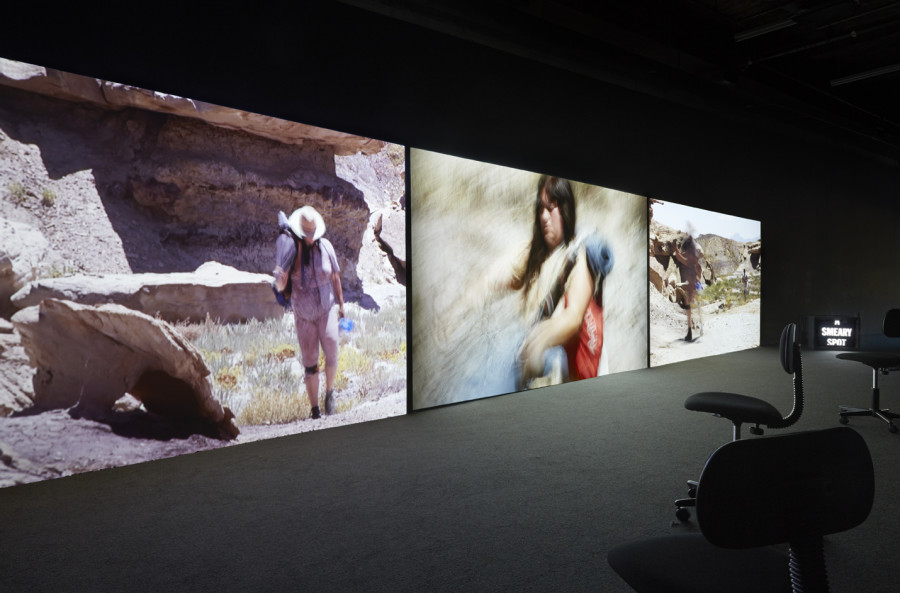
Installation view of A Smeary Spot, 2015 4-channel video installation Videos 1-3, HD color, 6-channel sound, TRT 53:13 minute synchronized loop; and video 4, SD b/w, silent, TRT 4:00 minute loop Dimensions variable, includes twelve office chairs, videos 1-3 each projected onto 81 x 144 inch walls, built at a 10 degree angle to the gallery wall, gallery is painted black with black industrial carpeted floor and video 4 is presented on a separate 29 inch-Sony cube-monitor. Courtesy of the artist and Callicoon Fine Arts, NY.
LK: I had known you went to Bard, but I didn’t know you went to RISD. I did my undergrad there in painting. Were you in the sculpture department?
AK: No, I was in graphic design actually. I had a crisis my freshman year debating between sculpture and design. My mom ended up having six kids, and she has always lived month-to-month, so I’ve always been paranoid about ending up broke. Maybe it’s now no surprise that W.A.G.E. would be part of my future. So I took the supposed “safe road” with design. But my thesis was basically an art project in book form, very influenced by The Annotated Topography of Chance by fluxus artist Daniel Spoerri. That was the first of many signs I was on the wrong path.
LK: So you were a practicing graphic designer?
AK: I graduated, then worked for a company doing packaging for computer games and realized very quickly, “This is garbage, I can’t do something I don’t care about.”
SM: Where were you?
AK: I went back to the Bay Area after RISD, and ended up in Oakland because it was 1998 and San Francisco had already dot-com boomed and was too expensive. I lived in the East Bay in various warehouses, quit my job 6 months after graduation to run my own design studio doing mostly book design and co-run a gallery space. I never took advantage of my ‘earning potential’ because I just couldn’t wrap my head around a job that served to promote commerce. I soon realized that I may have gone into design for the money, but money was not the thing that motivates me, and I needed an outlet that wasn’t subject to clients’ whims. So when I was 27, I moved to New York. And before I left Oakland, I staged a solo show in the gallery I had been running. That was my transitional commitment to being an artist.
SM: But your graphic sensibilities probably help you now, right?
AK: Oh yeah, I think it finds its way in. I mean, this whole project is very typographic. (pointing to steel fence pieces leaning against the wall of the studio that contain text—works that are now on view at Callicoon Fine Arts) I have a loathing for the graphic design industry, but I am actually a type nerd and love typography. Since writing and text continues to be more and more important in my work, I think it’s inevitable that typography will continue to creep in.
LK: It’s surprising to hear that you see it as a gradual process because I feel there’s so much interesting language that is generated by your work.
AK: Yes, its true the way that I think about symbols and language and meaning, is related to a kind of graphic design thinking. But I think I had to resist graphic design so it could find a new form within an art practice.
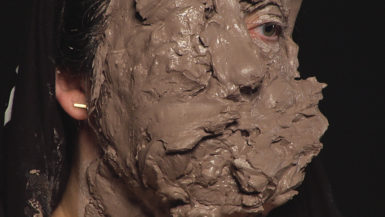
Still from ‘A Smeary Spot’, 2015. Courtesy of the artist and Callicoon Fine Arts, NY.
SM: So how many years were in between RISD and Bard?
AK: I didn’t go to grad school until I was in my early thirties. I think when I got out of undergrad I felt very done with school and wasn’t interested in getting into any more debt. And then, obviously, a lot of things shifted in my life. I did Oakland for five years, until I had my mid-20’s life crises that prompted my move to New York, where I dropped right into the beginnings of LTTR. It was 2003, so I think the second issue was in the works. I got invited into LTTR because K8 Hardy, Emily Roysdon, Ginger Brooks Takahashi and many other artists that made up LTTRs extensive collective effort were close friends with the person I was dating at the time. This extended family of queer feminist artists really shaped me as an artist. We shaped each other. So, NY took a few years of getting settled into, and then I finally decided to apply to grad school.
LK: What’s really fascinating to me about your work is that there’s a lived-ness in the way your objects and references come together, in a way that I find very believable.
AK: When I got to Bard I was still a little uptight and didactic - leftovers from my design training. I’ve always been heavy on the conceptual bit, the thinking that goes into my work. Being at Bard shifted my concerns towards integrating more physical, formal and material concerns. And Taylor - do you know Taylor?
LK: Taylor Davis?
AK: Yeah, she’s here in Boston. She’s the head of sculpture at Bard and also teaches at MassArt. She’s incredible and I would say my biggest mentor. But she’s a mentor to a lot of people. She’s unique for me but I don’t know if I’m unique for her. You know how it is when you’re a teacher. You’ve influenced a lot of people, but for the student you’re that one person.
LK: Now you teach, so you know this from experience!
AK: Yes, but even the way I teach is influenced by Taylor. She’s a formalist in a lot of ways, and at that time, I really needed someone to come to me with formal questions. She just made me look, feel, move things, test things, spend time with things, and understand what the materials were doing differently than language. The other person who’s been tremendously influential to me is Steiner (A.L. Steiner). Collaborating with Steiner on Community Action Center and W.A.G.E. both started while I was at Bard.
LK: Was Steiner part of LTTR?
AK: She showed up around the end of LTTR. She had been around, but our worlds didn’t come into focus until close to the last issue. And then Ridykeulous started, which is a project by Nicole Einsenmann and Steiner. And I worked with them on a few projects too. I think we met at The Hole where Kim Anne Foxman threw a weekly lesbian party called Mad Clams.
SM: Steiner gave you a different kind of mentorship or friendship?
AK: No, I wouldn’t call it a mentorship. We share an intuitive collaborative space that I haven’t experienced before or since. Steiner is older than I am, but we came together as peers.
SM: It seems like you’ve been working collaboratively for many years, even prior to Community Action Center.
AK: No, Community Action Center is what kicked off my collaboration bender. I guess you could say that I was working collaboratively because I was working with LTTR and Ridykeulous, but really those are collectives in which there is a core group of people who make all the decisions, and they invite you in depending on the project. So it’s very different to actually collaborate and conceive something together. Community Action Center came from the two of us joking around that there was no decent lesbian porn to watch.
LK: You’re not talking about lesbian porn made for straight guys?
AK: Noooo, I’m talking about porn made by and for queer womyn. Not straight - that’s a whole other genre—the male fantasy version—that is even more depressing to watch, because it’s so robotic, like you can tell the women don't really feel passionately about that vagina. If they did they would cut their finger nails. There’s some queer-run porn companies out of San Francisco and other places. But I would say a lot of porn in general, and not just lesbian porn, is contrived-feeling. I also think that in queer porn there’s a lot of mimicking of hetero activity— for example the ‘butch’ strapping it on and fucking a ‘femme’, so binary! Why is this the dominant image? What about the entire body as a sexual organ, why limit yourself physically and visually? I just don’t understand why women and queers in general aren’t making more porn that feels completely unique. Why mimic the male gaze?
SM: I’m always struck by the bad conversation that leads up to porn. There always has to be some kind of talking.
AK: Oh yeah, that was one of our first rules: no script, no talking. Who needs to see people chat, but we did having intimate singing and poetry which I think are both sexier forms of verbal engagement. The thing with collaborating with Steiner is that she's more of a documentary photographer, and I’m very much a maker/stager of things. So if you look at Community Action Center, it's like a quasi documentary-fantasy. It’s something that could only come from the merging of our two sensibilities. I think when you look at Steiner’s photography, what’s really beautiful is that it’s very candid as if that’s just how everyone lives all the time. Steiner works through spontaneity. And while I don’t need things to be precisely planned, I tend to be more detail-oriented. Steiner brought a “keeping the conversation going” kind of energy that I now see as fundamental to the way I work. In my own video works I don’t do storyboards. But I do collect a lot of images, props, puns, esthetics and ideas. I build a loose cosmology and then I bring everything into the room and do what Steiner and I coined as “soft directing.” So the work relies, to a certain degree, on the energy in the room and the people you invite into the work.
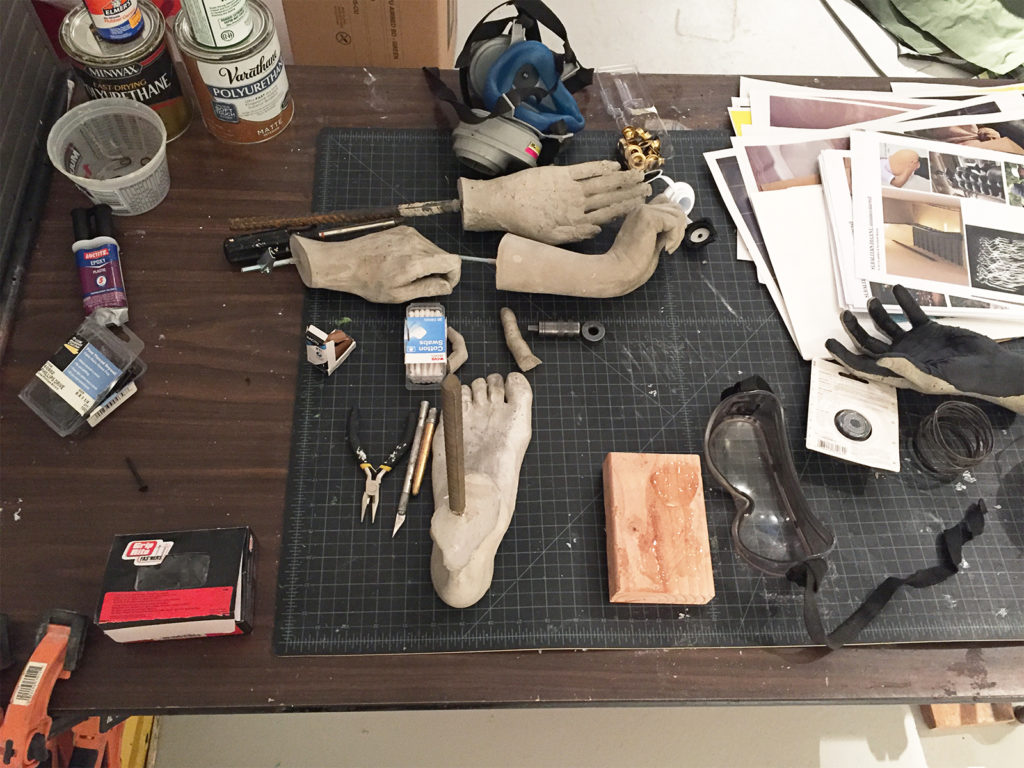
Image from artist's studio at Radcliffe Institute for Advanced Study at Harvard University, 2017. photo: Lucy Kim.
LK: Did you always have this kind of open-ended approach?
AK: Neither Steiner nor I had made anything this ambitious when we started working together. The longest video piece I had made up to that point was three minutes and working with two or three people. So it was a huge leap to make a 70-minute work. I didn’t know I could make a project at that scale or how I would approach it. Our methods developed through making it and I definitely carry that process into my solo video works.
SM: Do you devote time to research, or are you kind of working continuously?
AK: There’s a research phase, but some of that research comes from following impulses and just living life. Its not inherently organized research time, I might just call it the searching phase. As soon as I was done exploring ‘porn’ I felt an urge to work through another genre, this time science fiction. By the way, the next one is horror. (laughs) I’m interested in genres because they give me something to push against - I don’t care about staying true to a genre, rather I’m interested in finding its edges, exploring what it is through what it isn’t.
SM: With the sci-fi genre, is that filmic or literary?
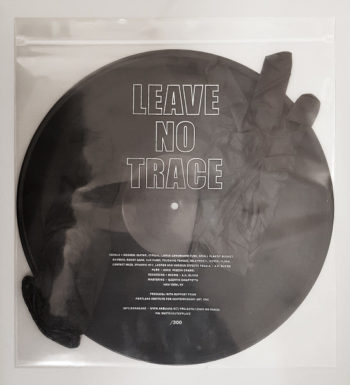
Leave No Trace, limited edition vinyl record with zip-bag, nitrile gloves and accompanying poem. Courtesy of the artist and Callicoon Fine Arts, NY.
AK: I’ve done more reading of books than watching of movies for this project, feminist or alt sci-fi, like Johanna Russ, Ursula K. Leguin, Samuel Delany, and Octavia Butler. But really Karen Barad’s writing that expands feminist critique through quantum field theory has been the most influential. Which is the inverse process we had with the ‘porn’ (Community Action Center). For that, we watched a lot of films, in particular what we called gay liberation porn, mostly from the 70’s. Works by Fred Halsted, Joe Gage, Wakefield Pool. Those films were gorgeous and fetish-y.
LK: By fetish-y do you mean the objects and outfits?
AK: Like some guy coming out of the forest and finding a sock and sniffing it, just really sensual stuff. They are excellent films that happen to be sex films.
LK: Tell us about the process behind A Smeary Spot.
AK: I was visiting Utah on a road trip not long after I decided on working on a science fiction. The deserts there are almost a cliché— they evoke an otherworldliness despite being terrestrial. And not surprisingly numerous science fiction films have been shot in Utah.
SM: And that’s also where astronauts train for lunar landings in their space suits. It makes total sense.
AK: Totally. While roaming in south-central Utah, I rediscovered public lands and got fascinated by this socialist anomaly existing within our culture of entrenched capitalism. There’s no obvious entrance or exit when on public lands, or obvious rules. You have to move every fourteen days so you can just live there if you’re willing to be nomadic. And 70 percent of the land in Utah is public, so it's a massive amount of land.
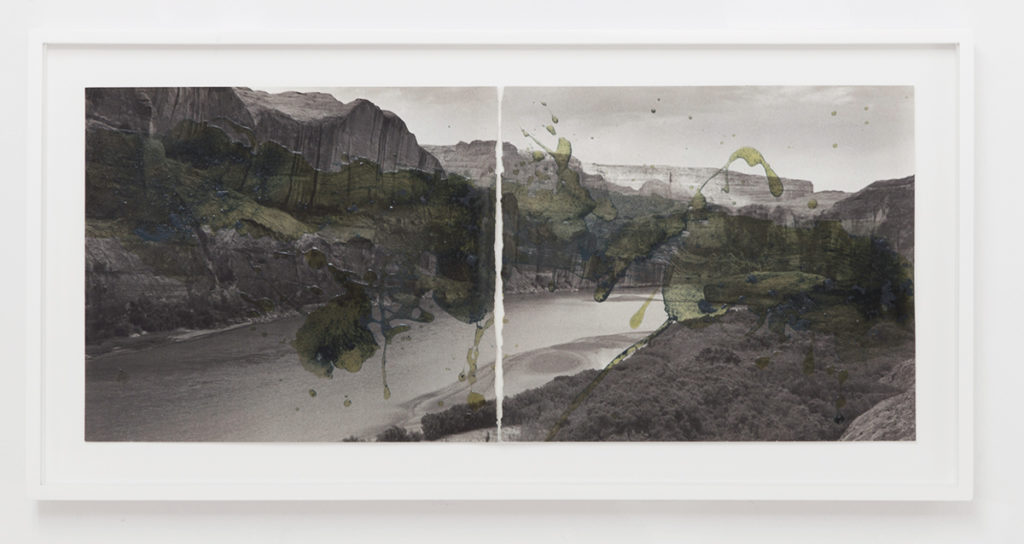
before the wake, spirulina, polyurethane, and images ripped from a photographic catalog, 21 x 9 inches. Courtesy of the artist and Callicoon Fine Arts, NY.
SM: So people are there living that way?
AK: Yeah you’ll run into folks occasionally who have clearly been on the land for a while. It got me thinking about land and property, and how the division of space shapes both society and politics and thereby the formation of being. So my experiences there became the philosophical basis for the work. Then I collected funding resources and reference images to build a constellation of ideas, esthetics and ‘characters’. I don’t try to create any logical narratives, I kind of plan things as loose vignettes that are a mash-up of signifiers—both formal and linguistic. I just have to trust that they will make sense together when I get to the editing process and be willing to throw out anything that doesn’t fit even if it was a lot of work to make a scene. It's a very inefficient process. And sometimes there are gaps that emerge and then at a later stage I’ll go back and shoot something with a real strong sense that it belongs somewhere specific in the work. The scene with Jen Rosenblit caking her face with clay was one of those scenes. It became very clear that I needed certain visuals elements that would move the viewer between the black box theater and the desert. Because those spaces are so starkly different, how are we to believe these two spaces make sense co-existing in one work? That scene was staged in the theater, but her face becomes like a landscape and sets the transition to another scene in the desert. There are conceptual reasons she’s engaged in this activity but equally important are the esthetic and physical aspects of that scene. The work aims to be experiential so that narrative logics cease to really matter.
LK: Will the upcoming Callicoon show - which will feature the works we’re seeing in your studio right now - have some element of A Smeary Spot or the newest video chapter Living Room, in there? Because I’m seeing a lot of pictures of landscapes in your studio.
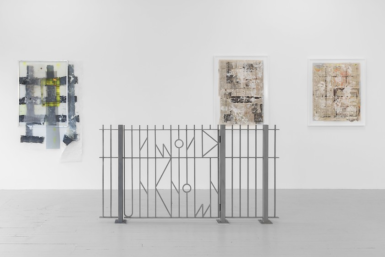
Installation view of Fault Lines at Callicoon Fine Arts, NY, 2017. Courtesy of the artist and Callicoon Fine Arts, NY. photo: Sean Fader.
AK: There are landscapes (laughs). Those are abstracted from an image of the unfinished pipe-line that was on the cover page of the New York Times a few weeks back. With Callicoon and the New Museum exhibitions—and A Smeary Spot for that matter—I’m giving myself permission to explore the politics of now through both utopic and dystopic fantasies. In the sculptures and wall works, for example, those images of the land (without the pipeline) are utopic. And the text in these gate/fence pieces stems from an evasive quote by Rumsfeld in response to inquiries about ‘weapons of mass destruction’—he catalyzes the fear of the unknown to the government’s advantage. But I’m most interested in inverting the negative connotations of the unknown. This inversion of the unknown also appears in A Smeary Spot, both the desert and the black box are sites of absence, voids or unknowns. I was interested in these undefined, non-proprietary spaces as realms of infinite potential, as highly generative utopias. Living Room (the central video installation at the New Museum) is very dark and dystopic, bodies are constantly under duress of some sort, until the last scene in the basement when there is a liberating dance sequence. In this scene, the dancers are all wearing t-shirts with language extracted from recent campaign slogans. So the shirts say “Or Bust,” “Her,” and “Again.” Those bodies are moving, dancing in and out of sync, recirculating and reinscribing this language with a new form of agency. The video works are all set in a speculative present, where the now and fantasy can interact. At Callicoon I don't want to just display props from the videos, so I’m building on concepts and themes in the videos to create related material explorations. They are made with the idea that the sculptures can stand alone and the videos can stand alone, or you could put them in the same room and they would have an expanded conversation.
LK: This is the challenge I think. There’s this wanting for things to be diverse within a show, but then there’s this other pressure of consistency.
AK: The art market much prefers consistency. People love this idea that I’m a diverse practitioner, but it’s so much harder to build a career around, financially speaking.
LK: Sculptures are hard.
AK: Right, as is video installation, I don’t make it very easy for myself.
LK: But at the same time, you’re getting tremendous support right now.
AK: Right now is a dream! But I don’t know how I’ll be funding the work 6 months from now.
SM: The Radcliffe show will present older works that span many years. Is that unusual for you?
AK: I’ve never done this before. It’s like a micro-mini retrospective.
SM: The Thumb War video is one of your very early works?
AK: Yes, it's the first video I ever made and has actually never been installed before. Dina influenced the choice to show that piece.
LK: Dina Deitsch (Interim Director - Carpenter Center for the Visual Arts at Harvard)?
AK: Yes. One of the first times I met her, she told me she had recently shown my early video works to her students - she thought they were great. It hadn’t even occurred to me anybody was looking at my early video works, even though they are distributed by Video Data Bank. She said, “You should really show those!” I had been lamenting what I was going to show at the Radcliffe, because I was already a bit overwhelmed with the other two shows, so I jumped on her suggestion. Then I have a series of drawings “before the wake” that I mentioned earlier. In those works, over the images of Glen Canyon (before it was dammed), I made liquidy marks with a mix of spirulina and polyurethane. Very quick, gestural works in response to the submersion and loss of that landscape. The video piece is called Thumb War, which literally depicts a game of thumb war. It’s black and white, and shot very macro. It’s been slowed down so the motion and the audio have this animally-groaning quality. And I’ll show Leave No Trace, which is an experiment sound piece and poem that is the soundtrack for one of the forthcoming sci-fi chapters.
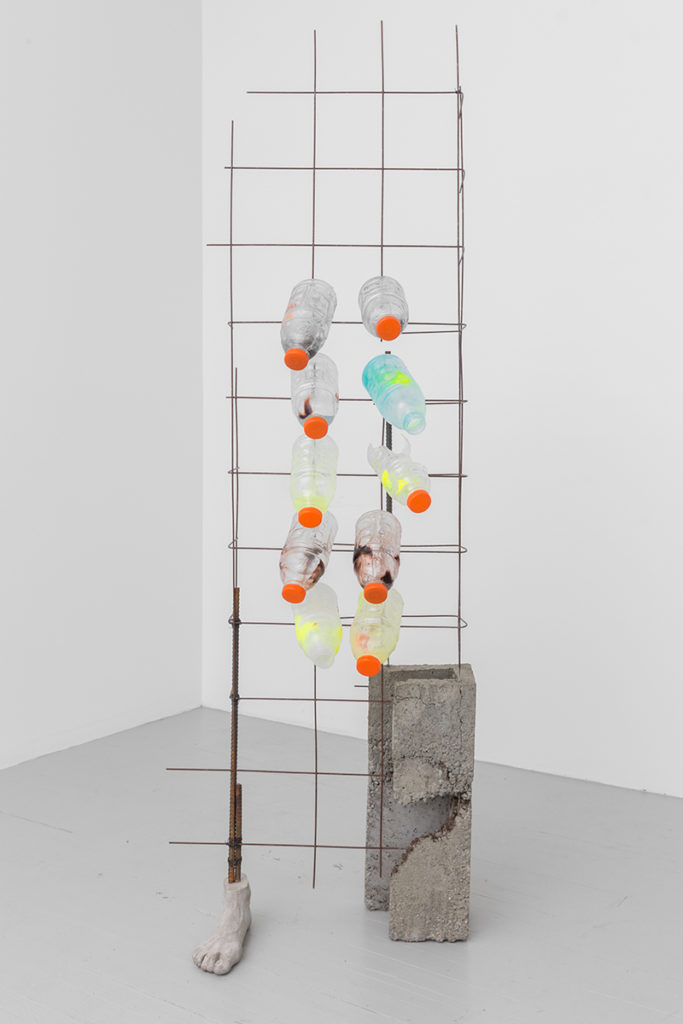
She Was Warned, 2017, cement hydrocal mix, concrete, rebar, steel wire, steel concrete reinforcement, plastic, pigmented resin
73 x 25 x 12 inches. Courtesy of the artist and Callicoon Fine Arts, NY. photo: Sean Fader.
LK: Isn’t your Callicoon show opening really soon?
AK: I have a week to finish it!
LK: Wow. Can you tell us about some of the works we’re seeing in the studio?
AK: There is a take on Artemis of Ephesus, over here (pointing to free-standing sculpture). All those Gatorade bottles are her breasts and she’s a post-apocalyptic interpretation of Artemis, the goddess of wilderness, the hunt, women and childbirth. She’s going to be assembled by the end of tonight. She’s got this beautiful hand with a gold-plated IUD dangling from it. The cast Gatorade bottles, unlike breast milk, offer up enhancement rather than sustenance.
SM: I’m seeing a lot of grids. Is that a running theme?
AK: Yes, I’ve been thinking a lot about lines and intersecting lines, or grids. Fences are a line that divides space, the title of the show is Fault Lines, and that led me into this whole visual space of the grid— as both a way of locating oneself in space and as a division of space.
LK: Will there be more than one Artemis sculpture?
AK: No, just one. She’s the allegory in the room. She’s just breasts and hand and foot. And IUD. This Artemis has been trashed, she is depleted. I think I might title this “She Was Warned.” The show is her, the fences, those pipe-line free landscapes, and a bunch of wall works many of which play formally with grids, some made with newspapers and some made with window screens.
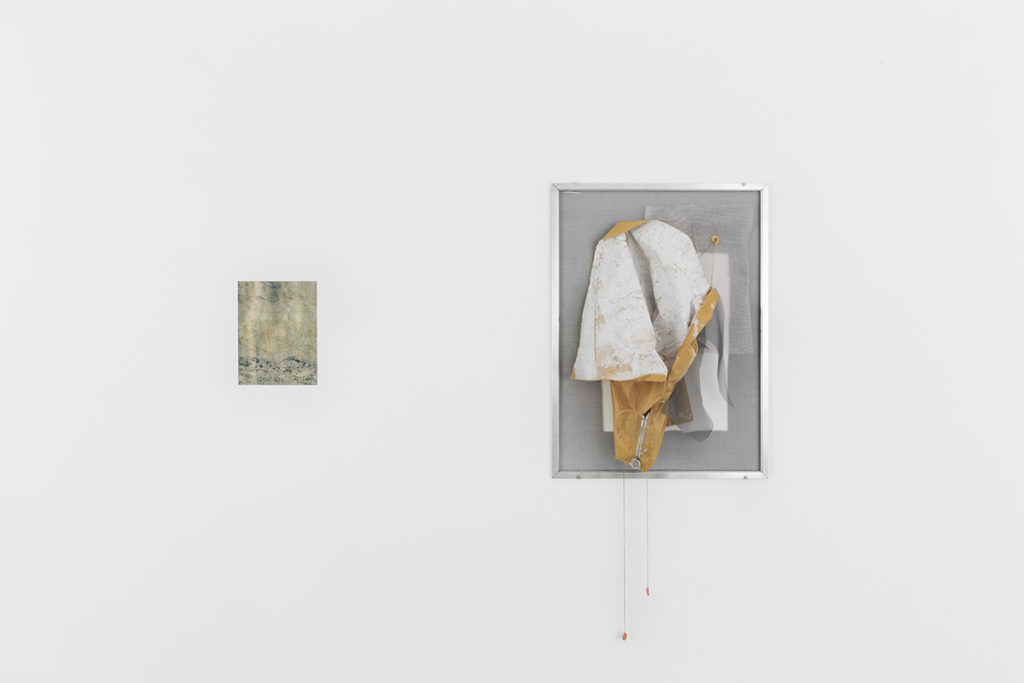
Installation view of Fault Lines, Callicoon Fine Arts, NY, 2017. Courtesy of the artist and Callicoon Fine Arts, NY. photo: Sean Fader.
This interview took place on February 12, 2017.
A.K. Burns is an interdisciplinary artist and educator residing in Brooklyn, NY, and a 2016-17 Radcliffe Fellow at Harvard University. She is the recipient of the Creative Capital Foundation Visual Arts Award, and is a founding member of W.A.G.E., and Randy magazine. Recent solo exhibitions include Shabby But Thriving at the New Museum, NY (2017), Fault Lines at Callicoon Fine Arts, NY (2017), and A Smeary Spot at Participant Inc., NY (2015) and Portland Institute of Contemporary Art (2016). She has an upcoming talk and exhibition, No Time, No Place, No Body, opening March 22, 2017 at the Radcliffe Institute for Advanced Study at Harvard University.

